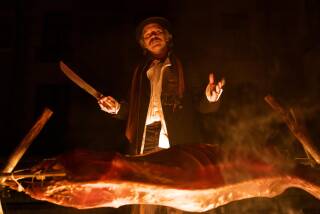The Plague From the Viewpoint of a Maid
- Share via
“Year of Wonders” attempts to bring to life, in a fictional form for the modern reader, the terror of the affliction of the bubonic plague on a small village in rural England in 1665. Geraldine Brooks succeeds admirably. A daughter, as she says, of the post-religious age herself, she turns her curious eye on human behavior at a time of overwhelming stress and pressure in a country just then moving from deep religiosity toward secular modernity.
Brooks, a former war correspondent and the author of two previous books of fiction, proves in “Year of Wonders” that she can indeed respond gracefully to the stern demands of her chosen art. Based on a historical event, the novel depicts the village of Eyam (pronounced “eem”) in the lead-mining and farming district of the mountainous spine of Derbyshire which was, alone among the county towns, afflicted with the plague. Urged on by the historic rector, the Anglican William Mompesson, whom Brooks calls “heroic and saintly,” the villagers quarantined themselves so that the contagion they carried would not afflict others.
They contained the disease to their own village, but two-thirds of them died of it. Mompesson sent his children away before the quarantine was agreed to. His wife stayed to nurse the sick, and she died of the plague, but her maid lived to do her mistress’ work. “Trying to imagine who this woman [the maid] could have been,” writes Brooks in an afterword, “how she may have lived and what she might have felt provided the voice for my novel.”
Brooks names the maid Anna, a young widow with two children of a kind and simple man who died young in a mining accident. Mompesson becomes the rector Michael Mompellion, who is given a fictional darker side to his saintly heroism. Brooks writes that she has drawn on “a wealth of anecdote handed down over the years”: the role of flea-ridden cloth from London as the possible carrier of the plague, the gravedigger who in his greed buried a man alive, the prescient cockerel who knew when it was finally safe to come home.
Her descriptions of the picturesque Derbyshire countryside are evocative, as are her sketches of the primitive lead-mining industry then invading it. Her characters, from the rector and his wife to the lord of the manor to the simplest folk, are believable. And the religious and moral aspects of her story are impressively rendered.
The Puritans, who had until recently held the village church and its parishioners firmly in their hands, taught that, as narrated by the maid Anna, “all actions and thoughts could only be one of two natures: godly and right, or Satanic and evil.” Anna takes this for granted, but some questions are raised in her mind by the presence in the village of a maker of curing potions and herbal mixtures. This woman did much good with her ministrations to the sick, yet, Anna says, “her fornication and her blasphemy branded her a sinner in the reckoning of our religion.”
Later, after much suffering and the appearance of ancient superstitions about the power of witches and the merits of flagellation nourished into new and terrible life by fear and despair, Anna stubs her toe and reaches a tentative position we would call modern.
“Why should this thing be either a test of faith sent by God, or the evil working of the devil in the world?” she asks. “One of these beliefs we embraced, the other we scorned as superstition. But perhaps each was false, equally. Perhaps the Plague was neither of God nor the Devil, but simply a thing in Nature, as the stone on which we stub a toe.”
Some writers of historical novels in English try to re-create the flavor of the diction and vocabulary of the speech of earlier centuries as Mary Lee Settle did recently for the 17th century in “I, Roger Williams” and Patrick O’Brian did for the 18th in his Aubrey-Maturin novels of the Royal Navy. Brooks generally writes in modern diction, though the reader would be advised to have a good dictionary on hand when encountering such archaic words as “stowe” (heap of ore), “blebs” (a blister on the skin) and “garth” (an enclosed yard or garden).
Though her expression is mainly modern, Brooks’ portrait is as faithful as we can hope for of people so much like us, yet so distant, ensnared in terror and grief, yet, some of them, courageous and even still capable of joy.
More to Read
Sign up for our Book Club newsletter
Get the latest news, events and more from the Los Angeles Times Book Club, and help us get L.A. reading and talking.
You may occasionally receive promotional content from the Los Angeles Times.










